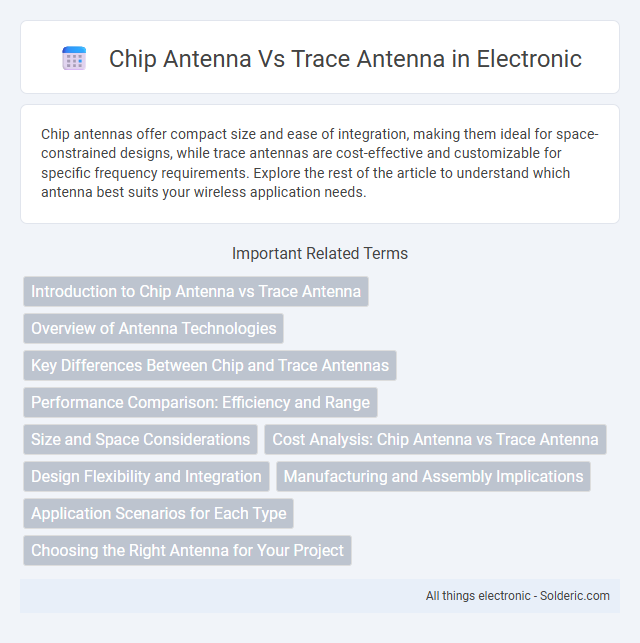Chip antennas offer compact size and ease of integration, making them ideal for space-constrained designs, while trace antennas are cost-effective and customizable for specific frequency requirements. Explore the rest of the article to understand which antenna best suits your wireless application needs.
Comparison Table
| Feature | Chip Antenna | Trace Antenna |
|---|---|---|
| Size | Compact, small footprint | Integrated on PCB, varies with design |
| Cost | Higher component cost | Lower cost, no additional component |
| Performance | Consistent, predictable radiation pattern | Depends on PCB layout, less predictable |
| Design Complexity | Requires antenna matching and tuning | Requires careful PCB design and spacing |
| Installation | Surface mount, easy to replace | Built-in, permanent on PCB |
| Application | Small devices, where space is limited | Custom boards, cost-sensitive designs |
| Frequency Range | Optimized for specific frequencies | Flexible, can design for multiple bands |
| Durability | Protected package, robust | Susceptible to physical damage on PCB |
Introduction to Chip Antenna vs Trace Antenna
Chip antennas offer compact, cost-effective solutions with predictable performance and easier integration on printed circuit boards, ideal for space-constrained applications. Trace antennas are etched directly onto the PCB substrate, providing low-profile designs with flexible pattern customization but potentially higher variability in performance due to substrate and environmental factors. Both antenna types play critical roles in wireless communication systems, with trade-offs involving size, efficiency, and design complexity.
Overview of Antenna Technologies
Chip antennas offer compact, ready-to-use solutions with consistent performance across various frequencies, making them ideal for space-constrained devices and rapid prototyping. Trace antennas, etched directly onto PCB substrates, provide customizable shapes and sizes, enabling tailored designs to optimize signal propagation and minimize interference. Both technologies utilize different fabrication methods and material properties, impacting their efficiency, bandwidth, and integration complexity in wireless communication systems.
Key Differences Between Chip and Trace Antennas
Chip antennas offer a compact, pre-manufactured design with consistent performance suitable for space-constrained applications, while trace antennas are custom-patterned directly onto the PCB, allowing greater design flexibility but requiring precise tuning. Chip antennas typically provide stable frequency response and easier integration, whereas trace antennas can be optimized for specific frequency bands and layouts but are more sensitive to PCB material and environmental changes. Your choice depends on balancing ease of integration with design customization and available PCB space to meet your wireless communication needs.
Performance Comparison: Efficiency and Range
Chip antennas generally offer higher efficiency due to their optimized design and controlled impedance matching, resulting in better signal strength and longer communication range compared to trace antennas. Trace antennas, etched directly onto the PCB, tend to have lower efficiency because of substrate losses and limited tuning capabilities, which can restrict your device's effective range in wireless applications. Choosing a chip antenna enhances performance in challenging environments where maximizing signal integrity and coverage is critical.
Size and Space Considerations
Chip antennas offer a compact size typically ranging from 3mm to 10mm, making them ideal for space-constrained designs in portable devices and IoT applications. Trace antennas are integrated directly onto the PCB, occupying minimal additional space but requiring more precise layout considerations to maintain performance. Selecting between chip and trace antennas depends on the available PCB real estate and the critical need to optimize size versus ease of integration.
Cost Analysis: Chip Antenna vs Trace Antenna
Chip antennas typically involve higher unit costs due to their compact design, manufacturing complexity, and material expenses, making them more expensive for large-scale production compared to trace antennas. Trace antennas, integrated directly onto printed circuit boards (PCBs), reduce assembly time and material costs, offering a cost-effective solution especially in high-volume manufacturing. However, chip antennas may provide better performance and size advantages that can justify the higher initial expenditure in applications demanding compact and efficient RF solutions.
Design Flexibility and Integration
Chip antennas offer limited design flexibility due to their fixed size and shape but provide straightforward integration as compact, ready-to-use components ideal for space-constrained devices. Trace antennas enable extensive design customization by varying shape, length, and layout directly on the PCB, allowing seamless integration tailored to specific frequency bands and device form factors. Trace antenna integration often reduces overall component count and can improve mechanical robustness, while chip antennas simplify assembly and manufacturing processes.
Manufacturing and Assembly Implications
Chip antennas offer compact size and consistency in performance, enabling automated surface-mount assembly processes that improve manufacturing efficiency and reduce labor costs. Trace antennas are integrated directly onto the PCB, simplifying the bill of materials and minimizing additional component placement, but require precise PCB design and fabrication to maintain signal integrity. Both antenna types impact assembly flow and yield rates, with chip antennas providing modular flexibility and trace antennas offering cost-effective, streamlined manufacturing.
Application Scenarios for Each Type
Chip antennas excel in compact devices requiring precise tuning and consistent performance, such as smartphones, wearables, and IoT modules operating in confined spaces with limited PCB real estate. Trace antennas are ideal for applications where design flexibility and cost-effectiveness are critical, frequently utilized in RFID tags, wireless sensor networks, and low-cost consumer electronics with larger PCB areas. Selecting between chip and trace antennas depends on factors like size constraints, frequency bands, manufacturing complexity, and integration requirements within specific communication devices.
Choosing the Right Antenna for Your Project
Choosing the right antenna between chip and trace options depends on your project's size constraints, frequency range, and performance requirements. Chip antennas offer compact size and consistent performance with minimal design effort, making them ideal for space-limited applications. Trace antennas, etched directly on the PCB, provide lower cost and customization flexibility but demand precise layout knowledge to optimize signal strength and range.
chip antenna vs trace antenna Infographic

 solderic.com
solderic.com